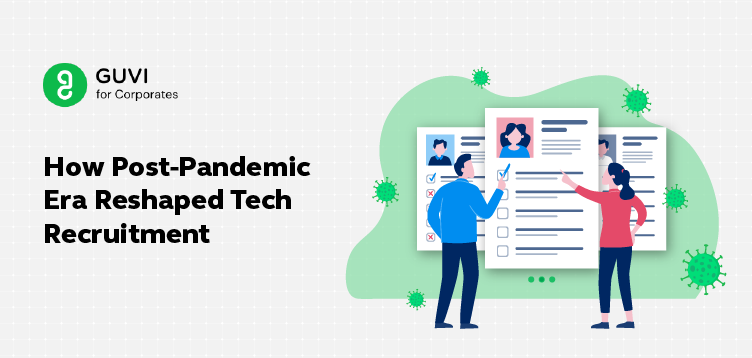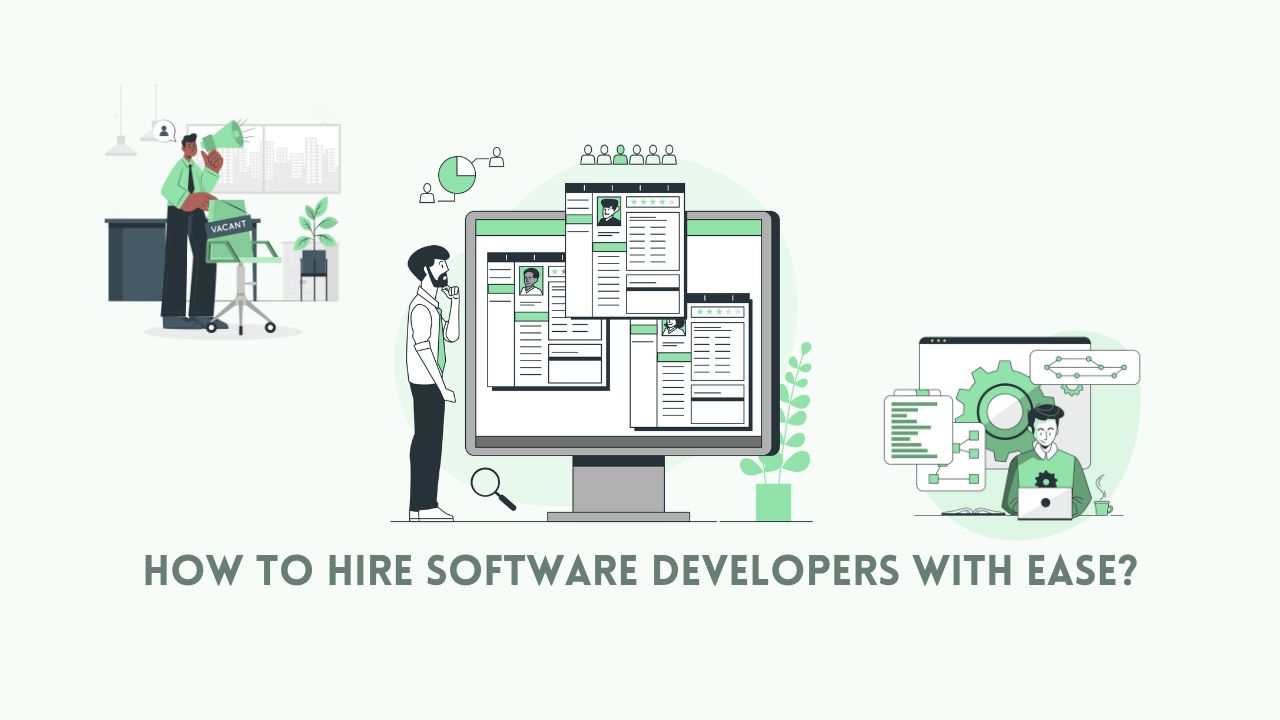
The 9 Stages of the Tech Hiring Process: A Comprehensive Overview
Sep 04, 2024 8 Min Read 2501 Views
(Last Updated)
The quality of its employees and their invaluable contributions are the foundation of any successful tech enterprise, regardless of size or product. Naturally, this makes hiring the right tech talent a responsibility that has to be undertaken with the utmost care and consideration. That’s why hiring an employee in the tech field, no matter the position or domain, involves a rigorous process to ensure that you identify and pick just the right gem for your organisation.
Navigating the labyrinthine process of tech hiring can be daunting, especially for startups, where each hire plays a pivotal role. While big enterprises have an army of HR representatives and a flood of applications for each position, startups and small companies often struggle to hire the right way without a proper tech hiring plan or resources in place.
But what are the various stages involved in a tech hiring process? What processes should a tech recruiter (or anyone looking to hire a tech expert) follow to acquire the best fit for your organisation? If you have been grappling with these questions, this comprehensive guide will answer all your queries regarding the stages involved in the tech hiring process, especially if you are recruiting for a small to medium-sized tech company. So, let’s dive deep!
Table of contents
- The Stages of Tech Hiring Process
- Identifying the Need or Position Required
- Sourcing Candidates from Various Channels
- Screening received Resumes and shortlisting candidates
- Conducting Preliminary Interviews
- Performing Skill Assessments
- Conducting Extensive Technical Interviews
- Conducting Behavioural Interviews to Find the Right Fit
- Salary Negotiation and Offer Extension
- Onboarding the New Recruit
- Making the Tech Hiring Process Efficient
- Final Considerations
- What is tech hiring?
- How do I define clear job requirements for tech roles?
- Why should I use technologies like ATS in the tech hiring process?
- How does HYRE help with the tech hiring process?
- How to make the tech hiring process efficient?
The Stages of Tech Hiring Process

The tech hiring process can be long and rigorous based on the seniority and domain of the required position. To find the fitting employee for the tech role, one must prepare a detailed tech hiring plan and attempt to hire the right candidate to fulfill the demands of the tech role within the available resources.
The following are key stages in a tech hiring process:
- Identifying the Need or Position Required
- Sourcing Candidates from Various Channels
- Screening received Resumes and shortlisting candidates
- Conducting Preliminary Interviews
- Performing Skill Assessments
- Conducting Extensive Technical Interviews
- Conducting Behavioural Interviews to Find the Right Fit
- Extending Offer and Salary Negotiation
- Onboarding the New Recruit
Each stage requires a careful assessment and analysis of the candidate from different perspectives. Let’s understand each stage of the tech hiring process with examples suggested by experts:
1. Identifying the Need or Position Required
Before embarking on the hiring journey, it’s crucial to identify the gaps in your current team. This stage lays the foundation for the entire hiring process. You would have to ascertain the hiring requirement, the domain, and the seniority of the position for which you want to hire. You can perform a needs assessment by conducting a SWOT (Strengths, Weaknesses, Opportunities, Threats) analysis to identify the skills and roles your team currently lacks.
For example, if you’re developing a SaaS product and find that your team is strong in backend development but lacking in UI/UX design, that’s a clear indicator of the role you need to fill.
Once you’re clear with your requirements, you need to draft a comprehensive job description that clearly outlines the skills required, the qualifications, experience level, and other eligibility criteria, as well as your expectations from the potential hires in terms of their day-to-day roles and responsibilities. For example, for a data scientist role, specify the experience range, programming languages, data modelling techniques, the potential product, and the data types they will be working with.
You have to ensure that the JD is accurate and specific to increase your chances of getting relevant applications. You can include more details about the company culture and environment to further invite the right fit for your organisation, which is equally crucial.
2. Sourcing Candidates from Various Channels

Once you’re clear on who you want to hire and what your potential hire will be working on, let’s get to the next stage of tech hiring. That is, putting out your hiring requirements through various channels and inviting applications that match the job description. For this step, you’ll have to decide the channel as per the kind of role, the experience level of the target candidates, and the domain. You see, finding the right candidates is akin to mining for diamonds; you need to know where to dig.
You can get help from various job boards or websites like Naukri.com, Shine.com, indeed, etc. Additionally, there are various niche or tech-specific platforms like Hasjob or AngelList India, which can bring you more targeted applications. For example, niche job boards like AI-specific portals can yield more targeted results for specialised roles like machine learning engineers, data scientists, deep learning engineers, etc.
Nowadays, many ed-tech startups are preparing skilled tech talent who are actively looking for their first jobs. Additionally, hiring tech freshmen directly from colleges and universities is a traditional way that you can go. You must also leverage professional networks such as LinkedIn and various tech meetups to find quality candidates. Example: If you’re looking for a DevOps engineer, attending a DevOps-focused meetup can provide valuable connections.
If you’re posting the job opening on your website, you should also include more about the working environment at your company, the culture, and employee testimonials to attract candidates who actually want to work with you and deliver their best performance in a conducive environment.
Also read: Use these Strategies for Effective Tech Talent Sourcing
3. Screening received Resumes and shortlisting candidates

The resume screening stage is your first filter, helping you sift through the candidate pool to find potential matches. Once the resumes start flowing in for the job position, you must start shortlisting based on various criteria. You can start by matching the skills mentioned in the resume.
If there are a lot of resumes, then you can use an Applicant Tracking System (ATS) to filter resumes based on keywords that match the job description to make the process more efficient. Say you’re hiring for a Python developer, the ATS can filter out resumes that don’t mention Python or related frameworks.
After this, you can further look at the experience that you need in the potential hire. If they have experience with the same field as your product, even better! For example, a candidate with 2 years of experience in fintech could be more valuable for a fintech startup than someone with 5 years in a different sector.
4. Conducting Preliminary Interviews

Now that you have the shortlisted bunch of candidates based on the resumes you liked, the next stage in the tech hiring process is to conduct the first set of interviews. The preliminary interview serves as the first human interaction with the candidate. It’s a chance to gauge not just their qualifications but also their interest in the role and the company.
The initial screening could be more like a light introduction. You can either conduct a brief telephonic or video interview to assess the candidate’s communication skills and enthusiasm for the role. It would help you further narrow your list based on first impressions, their awareness of the company, the product, their research abilities etc.
To give you an idea, you can ask questions like, “What interests you about this role?” or “How did you hear about our company?” to gauge their interest and research efforts.
Before we continue with the subsequent stages, consider getting started with GUVI’s Business Analytics and Digital Marketing Career Program, which lets you gain practical experience by developing real-world projects and covers technologies including Power BI, Excel, SQL, Tableau, Data Visualization, etc. for a thorough hold over the field.
Additionally, if you would like to explore Marketing Research Techniques through a self-paced course, try GUVI’s Marketing Research Techniques Self-Paced certification course.
5. Performing Skill Assessments
After the preliminary interviews, we come to one of the most important stages of the tech hiring process: skill assessments. For a tech role, assessing the skill level is absolutely important as it provides a hands-on evaluation of how well the candidate can perform tasks they will encounter on the job. It would offer insights into their problem-solving and logical skills as well as their ability to apply their learnings in a practical setup.
For starters, you can assign them some real-world tasks that mirror the responsibilities they would assume if hired. It could be a coding task or a comprehensive task within a stipulated amount of time that tests their overall practical skills. Most of the tech roles require a strong base in technical concepts. For example, a test for a front-end developer role could involve creating a simple webpage or modifying an existing one. You can get the task evaluated by a senior developer!
You can easily test the same by taking a technical test that would test their theoretical knowledge as well as skills in real case studies. You can utilize platforms like HYRE to administer conceptual tests as per your requirements and provide a comprehensive, unbiased assessment of their technical skills with time and resource efficiency.
6. Conducting Extensive Technical Interviews

Once the potential pool of candidates clears the skill assessment stage, we move to the technical interview step, which is a critical juncture in the tech hiring process. It serves as the litmus test for evaluating a candidate’s technical prowess and problem-solving abilities. This stage is particularly crucial for startups, where each team member often wears multiple hats and is expected to contribute significantly to the project’s success.
Based on the skill assessment test performances, you can confirm the candidate’s conceptual prowess and the ability to think on their toes when presented with real-world tech problems. Your aim will be to assess the candidate’s ability to solve complex problems under time constraints. The technical interview also provides a clear view of the candidate’s coding style, efficiency, and adherence to best practices.
To foster better understanding, let’s look at a couple of examples:
Suppose you are hiring for a backend developer role focused on Java. You could present a real-world problem that your company has faced, like optimizing an existing piece of code for better performance. This not only tests their Java skills but also gives you an insight into their problem-solving approach and adaptability when presented with challenges.
If you’re hiring for a role that involves architecture or system design, you might ask the candidate to design a scalable and efficient system, like an e-commerce website. This will give you an idea of their understanding of databases, servers, and other system components based on the function of the system.
7. Conducting Behavioural Interviews to Find the Right Fit
While the focus is on technical skills, it’s also important to include some behavioural questions to gauge how the candidate would fit into your team and culture. This brings us to the next stage of the tech hiring process.
You have to evaluate and understand the candidate’s values, work ethics, and alignment with your company culture and work environment. Questions like “Can you describe a situation where you had to adapt to a significant change at work?” can help you evaluate how they react to a situation.
Behavioural interviews are an excellent way to evaluate your potential hire’s soft skills, which hold an enormous value in today’s work culture. You must assess their communication skills, collaboration skills, and conflict management through situational questions.
For example, you could ask, “Can you describe a situation where you had to collaborate with a difficult team member? How did you handle it?” This gives you an idea of their interpersonal skills and conflict-resolution abilities.
Expert tip: Always give feedback to the candidates appearing for the interview. If they have made it so far, you should let them know if they are moving forward with the hiring either indicatively or upfront. If not, you can talk about what they could do better if they didn’t make the cut. You can convey your appreciation if you’re considering them for the offer round. This helps enhance your company’s reputation and keeps the process transparent and mess-free.
8. Salary Negotiation and Offer Extension
By now, you must have found the tech talent you were looking for. The next step is to make an offer that is both attractive to the candidate and sustainable for your company. Let your HR team have a salary negotiation with the selected candidate based on their expectations and the company’s budget for the role.
After successful negotiation and a little to-and-fro, if the candidate accepts the position, you will need to extend a formal job offer, detailing the terms of employment, including salary, benefits, and reporting structure.
Also read: How to retain and attract quality tech talent
9. Onboarding the New Recruit
Once your chosen candidate has accepted the offer, all you need to complete is the final stage of the tech hiring process: a smooth onboarding process. You can provide an orientation of the company and their role, where you can introduce them to the team, the work culture, and the tools and technologies they’ll be using.
You can also offer comprehensive training sessions at the beginning to equip them with the knowledge and resources they need to excel in their role. Mould your talent to the needs of your company and watch them become a useful resource and invaluable asset for your company. You can also understand their proficiency or interest in a particular task or niche and assign them a team accordingly.
That’s it! These are the key stages of a usual tech hiring process. You can always increase or decrease the stages based on your organizational requirements. We know, it looks really cumbersome and resource-consuming. Fortunately, with the technical advancements, many efficient tools and platforms in the market can help you automate the tech hiring process and effortlessly save time, energy, cost and resources that go into hiring for the tech domain.
Here’s what you can do:
Making the Tech Hiring Process Efficient
There are a few basic yet crucial things you can opt for to make your tech hiring process much more efficient, quick and seamless. You can automate the whole assessment process and reduce the cost-per-acquisition, and the time consumed in hiring and save on important company hours by just employing a talent assessment tool!
If you are looking for such an all-rounder tool, explore HYRE, a 360-degree, AI-powered assessment tool by GUVI for corporates. HYRE comes with a pre-structured assessment pipeline– a seamless end-to-end recruitment process & competency screening that filters the best candidates by conducting regular assessments, HR screening calls & technical interviews. All of this is trackable using a structured assessment pipeline so you don’t miss out on anything.
It has a great library with questionnaire templates with customizable difficulty levels for individual job roles. It enables you to schedule tests at the preferred time and date at your organization’s convenience. You can also automate tests and send them to any number of candidates at a set date, time, and event. HYRE streamlines the proctoring & evaluation process involved in talent acquisition, making the job easy for recruiters.
You can also track your efforts through an all-in-one dashboard. This analytical space helps to get time-to-time, instantaneous reports, and keep your metrics in check, including the total number of candidates, candidates who appeared for the test, number of candidates hired for the role, number of tests that ran successfully, templates employed, and more.
With HYRE, You can monitor candidates’ performance and detect suspicious activities like copy-paste, tab switch, idle movements, unusual responses, etc. Record your candidates’ performances in video snippets. Review them later when you interview the candidate or if needed. This way, you can understand the genuineness of the candidate and avoid misconduct or any suspicious activities during the assessment.
HYRE’s AI-based video surveillance is a time-saving and efficient way to ensure productivity in the recruitment process. This feature enables you to automatically detect abnormal movements, unusual occurrences, malpractice, or any mishaps during the assessment sessions.
The applicant tracking system in HYRE streamlines your recruiting process, filters out the candidates, and drives you toward the right fit for your organization. This feature serves as a control hub for candidate management and reduces your cost-per-hire as well.
We talked about assessment, but what about sourcing the right fit? GUVI for Corporates Hiring offers a set of handpicked tech talent equipped with the top industry skills who are ready to join immediately. They have a talented pool of freshers who are masters of their domain, trained under industry experts through hands-on learning. There’s more! Just let them know your requirements and get filtered resumes delivered to your inbox. With GUVI for Corporates hiring, you can close recruitment within 1 week for any tech domain based on your needs.
Want to bridge the skill gap between your recruits and your expectations? Employ GUVI for Corporates’ Corporate Training services to administer affordable, yet effective tech training, tailored according to individual designations and domains to optimize performance. Let them identify the skill gap and deliver a personalized training suite to scale your organizational needs.
Kickstart your career by enrolling in GUVI’s Business Analytics and Digital Marketing Career Program where you will master technologies including Power BI, Excel, SQL, Tableau, and Data Visualization, and build interesting real-life business-analytics projects.
Alternatively, if you want to explore Marketing Research Techniques through a Self Paced course, try GUVI’s Marketing Research Techniques Self Paced certification course.
Final Considerations
Tech hiring is a complex but rewarding process. Each stage is a stepping stone towards building a team that not only possesses the right skills but also fits seamlessly into your company culture. By following the steps in this guide, even a small tech company or startup can hire smartly and efficiently without compromising on the quality of the talent.
Till now, you must have gathered that tech hiring isn’t like the usual recruitment process. Here, core technical skills take centre stage, while overall personality and proficiencies remain in the foreground. Tech hiring stages ensure clarity, transparency, and minimal discrepancy on both ends, which is why such recruitment needs to be well-organized and executed.
With GUVI for Corporate’s suite of tech hiring tools, any startup or enterprise can streamline all the stages of their tech hiring process at almost zero extra cost and extra efficiency while saving time and resources, which you can use to drive better results every time.
FAQs
What is tech hiring?
Tech hiring is the process of recruiting technical talent for IT and tech-related roles in domains like software development, web development, DevOps, data science, machine learning, AI, etc. The process starts by identifying the requirements, followed by sourcing candidates, testing their technical skills, interviewing them thoroughly, and finally ends with extending an offer and onboarding.
How do I define clear job requirements for tech roles?
Work closely with hiring managers and tech leaders to create detailed job descriptions. Outline specific technical skills, experience levels, responsibilities, and any other qualifications necessary for success in the role. Ensure that these requirements align with your organization’s goals and the needs of the team.
Why should I use technologies like ATS in the tech hiring process?
Applicant Tracking Systems (ATS) is really helpful in the tech hiring process as it helps streamline candidate management. Additionally, AI-powered tools can help match resumes to job descriptions, making it easier to identify qualified candidates quickly. This saves a lot of company time, resources and cost while making the entire hiring process extremely efficient and fast.
How does HYRE help with the tech hiring process?
HYRE is one of the best recruitment tools for Effective Tech Talent Sourcing that you invest in. It is easy to use and involves very little admin intervention after setup. Here are more reasons why Hyre would be your right recruitment partner:
1. Time-Saving
2. Simplified Assessment processes
3. Trackable Results
4. User-friendly interface
5. Efficient Co-branding
6. Effortless with reusable templates
7. Room to create new templates
8. Flexible test Scheduling
9. Effective, video-based proctoring
10. Accurate Evaluation
How to make the tech hiring process efficient?
Make the tech hiring process efficient and faster by employing 360-degree hiring solutions like HYRE. These tools make hiring very efficient by managing your applications, handling tech assessments for you, and evaluating those tests for you to save time, cost and make the process very fast as compared to manual hiring.
































Did you enjoy this article?